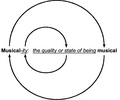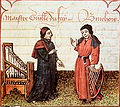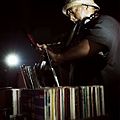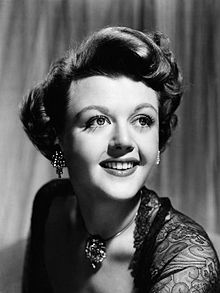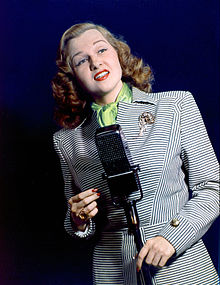Portal maintenance status: (April 2020)
|
The Music Portal
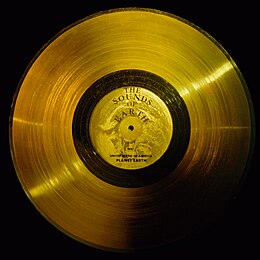
Music is the arrangement of sound to create some combination of form, harmony, melody, rhythm, or otherwise expressive content. Music is generally agreed to be a cultural universal that is present in all human societies. Definitions of music vary widely in substance and approach. While scholars agree that music is defined by a small number of specific elements, there is no consensus as to what these necessary elements are. Music is often characterized as a highly versatile medium for expressing human creativity. Diverse activities are involved in the creation of music, and are often divided into categories of composition, improvisation, and performance. Music may be performed using a wide variety of musical instruments, including the human voice. It can also be composed, sequenced, or otherwise produced to be indirectly played mechanically or electronically, such as via a music box, barrel organ, or digital audio workstation software on a computer.
Music often plays a key role in social events and religious ceremony. The techniques of making music are often transmitted as part of a cultural tradition. Music is played in public and private contexts, highlighted at events such as festivals and concerts for various different types of ensembles. Music is used in the production of other media, such as in soundtracks to films, TV shows, operas, and video games.
Listening to music is a common means of entertainment. The culture surrounding music extends into areas of academic study, journalism, philosophy, psychology, and therapy. The music industry includes songwriters, performers, sound engineers, producers, tour organizers, distributors of instruments, accessories, and publishers of sheet music and recordings. Technology facilitating the recording and reproduction of music has historically included sheet music, microphones, phonographs, and tape machines, with playback of digital musics being a common use for MP3 players, CD players, and smartphones. (Full article...)
General images - load new batch
-
Image 4The logo for Apple Inc.'s online iTunes store, which sells digital files of songs and musical pieces–along with a range of other content, such as digital files of TV shows and movies (from Music industry)
-
Image 5Drawing of the tablet with the Hymn to Nikkal (c. 1400 BCE), the oldest of the Hurrian songs (from History of music)
-
Image 6Pink Floyd (1973) performing The Dark Side of the Moon, a leading commercial success of the LP era (from Album era)
-
Image 11The Bull Headed Lyre of Ur, found in the Royal Cemetery at Ur, is the best known of the ancient Lyres of Ur (from History of music)
-
Image 12Guillaume Du Fay (left), with Gilles Binchois (right) in a c. 1440 Illuminated manuscript copy of Martin le Franc's Le champion des dames (from History of music)
-
Image 13c. 379 CE Bas relief of Sassanid women playing the chang in Taq-e Bostan, Iran (from History of music)
-
Image 14The monumental Bianzhong of Marquis Yi of Zeng, c. 5th century BCE, from Hubei (from History of music)
-
Image 16Sheet music for part of the Missa Papae Marcelli by Giovanni Pierluigi da Palestrina (from History of music)
-
Image 17Two musicians of the Eastern Han Dynasty (25–220 CE), Shanghai Museum (from History of music)
-
Image 18The Beatles (1964) have been credited by music historians for heralding the album era. (from Album era)
-
Image 19Taylor Swift, a longtime adherent to album-era rollouts, surprise-released her albums instead in 2020. (from Album era)
-
Image 21US vinyl sales in units, 1995–2020; while album sales overall declined, those in the vinyl format rose toward the end of the 2010s. (from Album era)
-
Image 22Terracotta statue of a Parthian lute player (from History of music)
-
Image 24Kanye West (2007) emerged during the decade as an important hip-hop producer and album artist. (from Album era)
-
Image 27Notation indicating differing pitch, dynamics, articulation, and instrumentation (from Elements of music)
-
Image 29The Japanese boy band Arashi, who had the world's best-selling album (5x20 All the Best!!) in 2019 (from Album era)
-
Image 34Frances Densmore at the Smithsonian Institution in 1916 where she was recording Blackfoot chief Mountain Chief for the Bureau of American Ethnology. In this picture, Mountain Chief is listening to a recording. (from Music industry)
-
Image 35An example of mechanically printed sheet music (from Music industry)
-
Image 36A musician in a recording studio (from Music industry)
-
Image 38A radio broadcasting system from 1906 (from Music industry)
-
Image 39A young man browsing through a record store in Bonn, West Germany, June 1988 (from Album era)
-
Image 40As LPs fell out of favor to CDs, hip hop producers repurposed them as sampling sources, contributing to the development of record collecting. (from Album era)
-
Image 41Platinum records by Elvis Presley, Prince, Madonna, Lynyrd Skynyrd, and Bruce Springsteen, at Julien's Auctions (from Album era)
 Featured articles - load new batch
Featured articles - load new batch
-
Image 1No Line on the Horizon is the twelfth studio album by Irish rock band U2. It was produced by Brian Eno, Daniel Lanois, and Steve Lillywhite, and was released on 27 February 2009. It was the band's first record since How to Dismantle an Atomic Bomb (2004), marking the longest gap between studio albums of their career to that point. The band originally intended to release the songs as two EPs, but later combined the material into a single record. Photographer Anton Corbijn shot a companion film, Linear, which was released alongside the album and included with several special editions.
U2 began work on a new album in 2006 with record producer Rick Rubin but shelved most of the material from those sessions. In May 2007, the group began new sessions with Eno and Lanois in Fez, Morocco, while attending the World Sacred Music Festival. Intending to write "future hymns"—songs that would be played forever—the group spent two weeks recording in a riad, with the producers involved in the songwriting process. The exotic musical influences that the group were exposed to in Fez inspired them to pursue a more experimental sound, but as the sessions unfolded, the band decided to scale back the extent of those pursuits. Having grown tired of writing in the first-person, lead singer Bono wrote his lyrics from the perspective of different characters. Recording continued at several studios in the United States, United Kingdom, and Ireland through December 2008. The group had intended to release No Line on the Horizon in November, but after composing 50 to 60 songs, they delayed the release to continue writing. (Full article...) -
Image 2
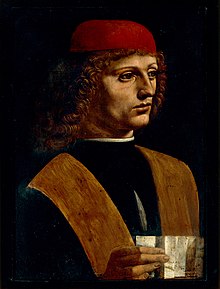
The Portrait of a Musician is an unfinished painting by the Italian Renaissance artist Leonardo da Vinci, dated to c. 1483–1487. Produced while Leonardo was in Milan, the work is painted in oils, and perhaps tempera, on a small panel of walnut wood. It is his only known male portrait painting, and the identity of its sitter has been closely debated among scholars.
Perhaps influenced by Antonello da Messina's introduction of the Early Netherlandish style of portrait painting to Italy, the work marks a dramatic shift from the profile portraiture that predominated in 15th-century Milan. It shares many similarities with other paintings Leonardo executed there, such as the Louvre Virgin of the Rocks and the Lady with an Ermine, but the Portrait of a Musician is his only panel painting remaining in the city, where it has been in the Pinacoteca Ambrosiana since at least 1672. One of Leonardo's best preserved paintings, there are no extant contemporary records of the commission. Based on stylistic resemblances to other works by Leonardo, virtually all current scholarship attributes at least the sitter's face to him. Uncertainty over the rest of the painting arises from the stiff and rigid qualities of the body, which are uncharacteristic of Leonardo's work. While this may be explained by the painting's unfinished state, some scholars believe that Leonardo was assisted by one of his students. (Full article...) -
Image 3"I Need You" is a song recorded by American socialite Paris Hilton. Michael Green produced the song and co-wrote it with Hilton and Simon Wilcox. Heiress Records released it as a digital download on February 14, 2018. A version of the song leaked in 2010, but Hilton said she re-recorded portions of the vocals and instrumental as a dedication to her fiancé Chris Zylka. It is a doo-wop and pop ballad that features holiday-related puns about love. Green based the single's style on 1950s music.
Critics praised "I Need You", partially as a departure from Hilton's previous dance-oriented and EDM songs. The single peaked at number 32 on the Dance Club Songs chart, Hilton's fifth appearance. A music video, directed by Zylka, was released on February 14, 2018, through Hilton's YouTube account. Inspired by Marilyn Monroe's performance of "I Wanna Be Loved by You" and Jessica Rabbit, the music video features Hilton wearing lingerie, posing in a bed covered with red rose petals, and popping out of a cake. Critics described the bed scene as a homage to the 1999 film American Beauty. Remixes by other artists, including Hector Fonseca, were released to promote the track. (Full article...) -
Image 41987 (What the Fuck Is Going On?) is the debut studio album by British electronic band the Justified Ancients of Mu Mu (the JAMs), later known as the KLF. 1987 was produced using extensive unauthorised samples that plagiarised a wide range of musical works, continuing a theme begun in the JAMs' debut single "All You Need Is Love". These samples provided a deliberately provocative backdrop for beatbox rhythms and cryptic, political raps.
Shortly after independent release in June 1987, the JAMs were ordered by the Mechanical-Copyright Protection Society to destroy all unsold copies of the album, following a complaint from ABBA. In response, the JAMs disposed of many copies of 1987 in unorthodox, publicised ways. They also released a version of the album titled 1987 (The JAMs 45 Edits), stripped of all unauthorised samples to leave periods of protracted silence and so little audible content that it was formally classed as a 12-inch single. (Full article...) -
Image 5R2K: The Concert was the first arena concert by Filipino entertainer Regine Velasquez, held on April 7 and 8, 2000, at the Araneta Coliseum in Quezon City. It was a part of Velasquez's promotion of her tenth studio album, R2K (1999). It was exclusively promoted by Viva Concerts, with beauty brands Pond's and Sunsilk as sponsors. Velasquez served as the stage and creative director for the show, which featured Ogie Alcasid, Gabby Eigenmann, Janno Gibbs, Jaya, and KC Montero as guest acts.
The concert's production and staging featured a 360-degree configuration with a semi-circular plexiglass stage, four large video screens, and an automated flying rig used during Velasquez's aerial performance of "On the Wings of Love" and "Butterfly". She collaborated on outfits with designer Rajo Laurel, who drew inspiration from Dolce & Gabbana's "print-on-print" collection. The set list included songs predominantly taken from R2K and various covers of pop hits from 1999 and 2000; these included "Larger than Life" by the Backstreet Boys and a medley of "If You Had My Love", "Waiting for Tonight", and "Let's Get Loud" by Jennifer Lopez, which she performed as part of the opening set. (Full article...) -
Image 6Elderly Instruments is a musical instrument retailer in Lansing, Michigan, United States, with a reputation as a "megastore", a repair shop and a locus for folk music including bluegrass and "twang". Specializing in fretted instruments, including acoustic and electric guitars, banjos, mandolins, and ukuleles, Elderly maintains a selection of odd or rare instruments. Elderly is known as a premier repair shop for fretted instruments, as one of the larger vintage instrument dealers in the United States, and as a major dealer of Martin guitars in particular.
Industry publications, music retail trade, and bluegrass music journals have featured articles about the Elderly repair staff. The company also provides consignment services for rare and vintage instruments. Since its founding in 1972, Elderly has undergone two major expansions: into mail order in 1975 and then into Internet sales in the 1990s. In 2005 it was the subject of a lawsuit by Gibson Guitar Corporation concerning trademark infringement. Today it is recognized internationally for its services and products; its mail order and Internet business account for 65–70 percent of its total revenue. Elderly grossed $12 million in 1999, and by 2007 was grossing $17 million annually. (Full article...) -
Image 7Song of Innocence is the debut album by American composer and producer David Axelrod. It was released in October 1968 by Capitol Records. In an effort to capitalize on the experimental climate of popular music at the time, Axelrod composed the album as a suite-like tone poem interpreting Songs of Innocence, a 1789 illustrated collection of poems by William Blake. Recording took place at Capitol Studios in Los Angeles with an orchestra and studio musicians from the Wrecking Crew collective, including keyboardist and conductor Don Randi, guitarist Al Casey, bassist Carol Kaye, and drummer Earl Palmer.
An instrumental jazz fusion record, Song of Innocence incorporates elements of classical, rock, funk, pop, and theatre music. Axelrod arranged the music for bass, drums, and string instruments, composing in a rock idiom with tempos centered on such rhythms played by Palmer. He used contrast in his orchestral compositions, interspersing their euphoric psychedelic R&B structures with dramatic, harrowing arrangements to reflect the supernatural themes found in Blake's poems. The resulting music's reverent, psychedelic overtones have been interpreted as evoking the poet's themes of innocence and spirituality. (Full article...) -
Image 8
Dame Angela Brigid Lansbury DBE (October 16, 1925 – October 11, 2022) was a British and American actress. In a career spanning 80 years, she played various roles across film, stage, and television. Although based for much of her life in the United States, her work attracted international attention.
Lansbury was born into an upper-middle-class family in central London, the daughter of Irish actress Moyna Macgill and English politician Edgar Lansbury. To escape the Blitz, she moved to the United States in 1940, studying acting in New York City. Proceeding to Hollywood in 1942, she signed to Metro-Goldwyn-Mayer (MGM) and obtained her first film roles, in Gaslight (1944), National Velvet (1944), and The Picture of Dorian Gray (1945). She appeared in 11 further MGM films, mostly in minor roles, and after her contract ended in 1952, she began to supplement her cinematic work with theatrical appearances. Lansbury was largely seen as a B-list star during this period, but her role in The Manchurian Candidate (1962) received widespread acclaim and is frequently ranked as one of her best performances. Moving into musical theatre, Lansbury gained stardom for playing the leading role in the Broadway musical Mame (1966), winning her first Tony Award and becoming a gay icon. (Full article...) -
Image 9"Lips Are Movin" is a song by American singer-songwriter Meghan Trainor, taken from her debut major-label studio album, Title (2015). It was written by Trainor and the album's producer, Kevin Kadish. Epic Records premiered the song on MTV News on October 15, 2014, and released it to the United States contemporary hit radio stations on October 21, as the second single from Title. A retro-tinged doo-wop and pop song with girl-group harmonies and bubblegum pop hooks, "Lips Are Movin" was inspired by Trainor's conflict with her record label. However, critical commentary has described it as a song about Trainor leaving her significant other after discovering he is cheating on her.
Critics drew similarities between the song's style and that of Trainor's debut single, "All About That Bass" (2014). Some deemed the song catchy, while others criticized its lyrics. In the United States, "Lips Are Movin" reached number 4 on the Billboard Hot 100 and was certified quadruple platinum by the Recording Industry Association of America (RIAA). It received platinum or multi-platinum certifications in Australia, Canada, New Zealand, and the United Kingdom, and reached the top 10 on their charts among others. (Full article...) -
Image 10
Jo Elizabeth Stafford (November 12, 1917 – July 16, 2008) was an American traditional pop singer, whose career spanned five decades from the late 1930s to the early 1980s. Admired for the purity of her voice, she originally underwent classical training to become an opera singer before following a career in popular music, and by 1955 had achieved more worldwide record sales than any other female artist. Her 1952 song "You Belong to Me" topped the charts in the United States and United Kingdom, becoming the second single to top the UK Singles Chart, and the first by a female artist to do so.
Born in remote oil-rich Coalinga, California, near Fresno in the San Joaquin Valley, Stafford made her first musical appearance at age 12. While still at high school, she joined her two older sisters to form a vocal trio named the Stafford Sisters, who found moderate success on radio and in film. In 1938, while the sisters were part of the cast of Twentieth Century Fox's production of Alexander's Ragtime Band, Stafford met the future members of the Pied Pipers and became the group's lead singer. Bandleader Tommy Dorsey hired them in 1939 to perform vocals with his orchestra. From 1940 to 1942, the group often performed with Dorsey's new male singer, Frank Sinatra. (Full article...) -
Image 11Zappa performing at Ekeberghallen in Oslo, Norway, in 1977
Frank Vincent Zappa (/ˈzæpə/ ZAP-ə; December 21, 1940 – December 4, 1993) was an American musician, composer, and bandleader. In a career spanning more than 30 years, Zappa composed rock, pop, jazz, jazz fusion, orchestral and musique concrète works; he also produced almost all of the 60-plus albums that he released with his band the Mothers of Invention and as a solo artist. His work is characterized by nonconformity, improvisation sound experimentation, musical virtuosity and satire of American culture. Zappa also directed feature-length films and music videos, and designed album covers. He is considered one of the most innovative and stylistically diverse musicians of his generation.
As a mostly self-taught composer and performer, Zappa had diverse musical influences that led him to create music that was sometimes difficult to categorize. While in his teens, he acquired a taste for 20th-century classical modernism, African-American rhythm and blues, and doo-wop music. He began writing classical music in high school, while simultaneously playing drums in rhythm and blues bands, later switching to electric guitar. His debut studio album with the Mothers of Invention, Freak Out! (1966), combined satirical but seemingly conventional rock and roll songs with extended sound collages. He continued this eclectic and experimental approach throughout his career. (Full article...) -
Image 12"Angel of Death" is the opening track on American thrash metal band Slayer's 1986 album Reign in Blood. The lyrics and music were written by guitarist Jeff Hanneman. They detail the Nazi physician Josef Mengele's human experiments at the Auschwitz concentration camp during World War II.
"Angel of Death" led to accusations of Nazi sympathizing and racism against the band, which they vigorously denied but which followed them throughout their early career. Despite the controversy and the resulting delay in the release of Reign in Blood, the song remained a live favorite, and has appeared on all of Slayer's live albums. (Full article...) -
Image 13New York Dolls is the debut studio album by the American rock band New York Dolls, released on July 27, 1973, by Mercury Records. In the years leading up to the album, the Dolls had developed a local fanbase by playing regularly in lower Manhattan after forming in 1971. However, most music producers and record companies were reluctant to work with them because of their vulgarity and onstage fashion as well as homophobia in New York; the group later appeared in exaggerated drag on the album cover for shock value.
After signing a contract with Mercury, the Dolls recorded their first album at The Record Plant in New York City with producer Todd Rundgren, who was known for his sophisticated pop tastes and held a lukewarm opinion of the band. Despite stories of conflicts during the recording sessions, lead singer David Johansen and guitarist Sylvain Sylvain later said Rundgren successfully captured how the band sounded live. The resulting music on the album – a mix of carefree rock and roll, influences from Brill Building pop, and campy sensibilities – explores themes of urban youth, teen alienation, adolescent romance, and authenticity, as rendered in Johansen's colloquial and ambiguous lyrics. (Full article...) -
Image 14Everywhere at the End of Time (commonly shortened to EATEOT) is the eleventh recording by the Caretaker, an alias of English electronic musician Leyland Kirby. Released between 2016 and 2019, its six studio albums use degrading loops of sampled ballroom music to portray the progression of Alzheimer's disease. Inspired by the success of An Empty Bliss Beyond This World (2011), Kirby produced Everywhere as his final major work under the alias. The albums were produced in Kraków and released over six-month periods to "give a sense of time passing", with abstract album covers by his friend Ivan Seal. The series drew comparisons to the works of composer William Basinski and electronic musician Burial, while the later stages were influenced by avant-gardist composer John Cage.
The series comprises six hours of music, portraying a range of emotions and characterised by noise throughout. Although the first three stages are similar to An Empty Bliss, the last three depart from Kirby's earlier ambient works. The albums reflect the patient's disorder and death, their feelings, and the phenomenon of terminal lucidity. To promote the series, anonymous visual artist Weirdcore created music videos for the first two stages. At first concerned about whether the series would seem pretentious, Kirby thought of not creating Everywhere at all, but he ended up spending more time producing it than any of his other releases. The album covers received attention from a French art exhibition named after the Caretaker's Everywhere, an Empty Bliss (2019), a compilation of archived songs. (Full article...) -
Image 15"Cry Me a River" is a song by American singer-songwriter Justin Timberlake for his debut solo album, Justified (2002). It was thought to be inspired by Timberlake's former relationship with singer Britney Spears. Jive Records released the song to contemporary hit and rhythmic radio in the United States on November 25, 2002, as the album's second single. Accompanied by an electric piano, beatbox, guitars, synthesizers, Arabian-inspired riffs and Gregorian chants, "Cry Me a River" is a pop and R&B song about a brokenhearted man who moves on from his past.
"Cry Me a River" received acclaim from music critics, who praised Timbaland's production while calling it a standout track on Justified. The song earned several lists of best of the year and the decade (2000s), while Rolling Stone included it on their 500 Greatest Songs of All Time at 484. It won the Grammy Award for Best Male Pop Vocal Performance at the 2004 ceremony. The song peaked at number three on the US Billboard Hot 100 and Pop Songs charts and charted in the top ten in other countries. It was certified double platinum by both the Australian Recording Industry Association (ARIA) and the British Phonographic Industry (BPI). (Full article...)
Selected pictures
-
Image 1Photograph: Roland FischerThe Zürich Opera House is an opera house in the Swiss city of Zürich. Located at the Sechseläutenplatz, it has been the home of the Zürich Opera since the current building was completed in 1891. It also houses the Bernhard-Theater Zürich.
-
Image 2Photo: ChrisHamburgOceana (born 1982) is a German singer of German/Martiniquen descent. She is shown here performing at the Radio Hamburg Top 820.
-
Image 3Thomas Linley the elder (17 January 1733 – 19 November 1795) was an English bass singer and musician. He began his musical career at age 11 in Bath, becoming apprentice to the organist Thomas Chilcot. Linley married in 1752 and fathered eight children, supporting the family by working as a music teacher. As his children grew he developed their musical talent and was able to draw an increasing amount of income from their concerts. When the Bath Assembly Rooms opened in 1771, Linley became musical director and continued to promote his children's careers. He was eventually able to move to London with the thousands of pounds which he had amassed from their concerts. In addition to his children Linley taught tenor Charles Dignum, singer and actress Anna Maria Crouch, and novelist Frances Sheridan. He collaborated with his son Thomas Linley the younger in penning the comic opera The Duenna, with libretto by his son-in-law Richard Brinsley Sheridan.
This picture is an oil-on-canvas painting created around 1770 by Thomas Gainsborough, showing Linley holding his "Elegies for Three Voices". It hangs in the Dulwich Picture Gallery, London. -
Image 4Photograph: Stefan KrauseHenrik Freischlader (b. 1982) is a German blues guitarist and singer. He began his career in 1998, and established his own label, Cable Car Records, in 2009.
-
Image 5Photograph: Georg Lindstrøm; restoration: Adam CuerdenCarl Nielsen (1865–1931) was a Danish musician, conductor and violinist, widely recognized as his country's most prominent composer. Initially playing in a military band before attending the Royal Danish Academy of Music in Copenhagen, he premiered his Op. 1, Suite for Strings, in 1888, at the age of 23. His early music was inspired by composers such as Brahms and Grieg, but he soon developed his own style. By the time of his death, he had produced 419 known works; some of these, such as his opera Maskarade (1906), have become integral to Denmark's national heritage.
-
Image 6Photograph: AiluraNina Sublatti (b. 1995) is a Georgian singer, songwriter, and model. Having previously won the 2013 Georgian edition of Idol, she achieved international attention when she represented her country in Eurovision Song Contest 2015 with her song "Warrior". She has since served as a judge on X Factor Georgia and Idols.
-
Image 7Photograph credit: William P. Gottlieb; restored by Adam CuerdenMary Lou Williams (May 8, 1910 – May 28, 1981) was an American jazz pianist, arranger, and composer. She wrote hundreds of compositions and arrangements and recorded more than one hundred records. Williams wrote and arranged for Duke Ellington and Benny Goodman, and she was friend, mentor and teacher to numerous other jazz musicians. The second of eleven children, she was born in Atlanta, Georgia, and grew up in the East Liberty neighborhood of Pittsburgh, Pennsylvania. A young musical prodigy, she taught herself to play the piano at the age of three. This photograph of Williams at the piano was taken by William P. Gottlieb around 1946.
-
Image 8Photograph credit: Fritz Luckhardt; restored by Adam CuerdenJohann Strauss II (25 October 1825 – 3 June 1899) was an Austrian composer of light music, particularly dance music and operettas. Part of the Strauss dynasty, his father demanded that none of his sons pursue music as a career, despite their display of musical talent. It was only after his father had abandoned the family for a mistress that the younger Strauss was able to develop his skills as a composer, with the encouragement of his mother. He eventually attained greater fame than his father, and became one of the most popular waltz composers of the era, conducting extensive tours of Austria, Poland and Germany with his orchestra.
-
Image 9Alexz Johnson (b. 1986) is a Canadian singer-songwriter and actress, best known for roles as Jude Harrison in the CTV series Instant Star (character shown here), Annie Thelan in the Disney Channel series So Weird, and as Erin Ulmer in the 2006 horror film Final Destination 3. Her album Voodoo was released in 2010.
-
Image 10Graphic: Giuseppe PalantiMédée is a French-language opera by the composer Luigi Cherubini. Set in the ancient city of Corinth, Greece, it features a libretto by François-Benoît Hoffman and is based on Euripides's tragic play Medea and Pierre Corneille's play Médée. The opera premiered in 1797 at the Théâtre Feydeau in Paris. The long-lost final aria, which Cherubini appears to have deleted from his original manuscript, was discovered by researchers from the University of Manchester and Stanford University by employing X-ray techniques to reveal areas that the composer had blackened out.
This picture shows the title page for a vocal score of the 1909 hybrid version of Médée. -
Image 11Photograph: Sven-Sebastian SajakHayley Williams (born December 27, 1988) is an American singer, songwriter, musician, and businesswoman. She serves as the lead vocalist, primary songwriter and occasional keyboardist of the rock band Paramore. Born in Meridian, Mississippi, Williams moved to Franklin, Tennessee, at the age of fifteen after her parents divorced. In 2004, she formed Paramore alongside Josh Farro, Zac Farro, and Jeremy Davis. The band currently consists of Williams, Farro and Taylor York. They have released five studio albums: All We Know Is Falling (2005), Riot! (2007), Brand New Eyes (2009), Paramore (2013) and After Laughter (2017).
-
Image 12Photograph credit: unknown; restored by Adam CuerdenSamuel Coleridge-Taylor (15 August 1875 – 1 September 1912) was an English composer and conductor. His greatest success was his cantata Hiawatha's Wedding Feast. This set the epic poem The Song of Hiawatha by Henry Wadsworth Longfellow to music, and was widely performed by choral groups in England and the United States. Composers were not well paid; the work sold hundreds of thousands of copies, but he had sold the music outright for the sum of 15 guineas, so did not benefit directly. He learned to retain his rights and earned royalties for other compositions after achieving wide renown, but always struggled financially. This photograph of Coleridge-Taylor was taken around 1905.
-
Image 13Photograph credit: William P. Gottlieb; restored by Adam CuerdenThelonious Monk (October 10, 1917 – February 17, 1982) was an American jazz pianist and composer, and the second-most-recorded jazz composer after Duke Ellington. He had a unique improvisational style and famously remarked, "The piano ain't got no wrong notes". He made numerous contributions to the standard jazz repertoire, including "'Round Midnight", and a wide range of other compositions. He was renowned for a distinctive dress style, which included suits, hats, and sunglasses. He had disappeared from the scene by the mid-1970s and made only a few appearances during the final decade of his life. This 1947 photograph of Monk was taken by the American photographer William P. Gottlieb in Minton's Playhouse, a jazz club in New York.
-
Image 14Photograph credit: Eugène Pirou; restored by Adam CuerdenJules Massenet (12 May 1842 – 13 August 1912) was a French composer of the Romantic era, best known for his operas. Between 1867 and his death, he wrote more than forty stage works in a wide variety of styles, from opéra comique to grand depictions of classical myths, romantic comedies and lyric dramas, as well as oratorios, cantatas and ballets. Massenet had a good sense of the theatre and of what would succeed with the Parisian public. Despite some miscalculations, he produced a series of successes that made him the leading opera composer in France in the late 19th and early 20th centuries. By the time of his death, he was regarded as old-fashioned; his works, however, began to be favourably reassessed during the mid-20th century, and many have since been staged and recorded. This photograph of Massenet was taken by French photographer Eugène Pirou in 1875.
-
Image 15Photograph: Achim RaschkaSimon Neil (b. 1979) is a Scottish vocalist, guitarist, and songwriter. Born in Irvine, he established the band Biffy Clyro in 1995 with James and Ben Johnston. He has also played with JP Reid of Sucioperro in Marmaduke Duke, using the pseudonym "The Atmosphere", and started a solo career.
Related portals
Did you know (auto-generated)

- ... that one critic interpreted a SZA song as being about her fears about the growing influence of AI in the music industry?
- ... that husband and wife Edward M. and Marie Zimmerman co-wrote the suffragist anthem "Votes for Women: Suffrage Rallying Song"?
- ... that a performance by Milkie Way at the 2021 Heavy Music Awards got its Twitch stream banned for three days?
- ... that Steve Elcock's Symphony No. 6 is dedicated to "the everlasting execration of self-serving politicians, the obscenely rich and the system that allows them to remain so"?
- ... that Felipe Lara's Pulitzer finalist Double Concerto turns its soloists into a "many-tentacled creature"?
- ... that Max Weil, founder of the Halifax Symphony Orchestra, spent his later years in real estate?
- Birthdays in Music: September 19
- Sylvia Tyson, Canadian singer and multi-instrumentalist, solo and with Ian and Sylvia , turns 84.
- Bill Medley, American singer, songwriter and one-half of The Righteous Brothers, turns 84.
- Freda Payne, American singer and actress, turns 82.
- David Bromberg, American guitarist, turns 79.
- Lol Crème, British musician and music video director and member of soft rock group, 10cc, turns 77.
- Daniel Lanois, Canadian singer, songwriter, and music producer, turns 73.
- Nile Rodgers, American arranger, composer, guitarist and music producer, co-founding member of R&B/funk act, Chic, turns 72.
- Rex Smith, American singer and actor, turns 69.
- Rusty Egan, Brit drummer for The Rich Kids, Sex Pistols, turns 67.
- Tatsu Aoki, Japanese bassist, turns 67.
- Sally Barker, Brit guitarist, turns 65.
- Jeff Bates, American country music singer, turns 61.
- Jarvis Cocker, Brit vocalist with Pulp, turns 61.
- Trisha Yearwood, American country music singer and TV personality, turns 60.
- Candy Dulfer, Dutch saxophonist, turns 55.
- Paul Winterhart, session musician with Kula Shaker, turns 53.
- A. Jay Popoff, American drummer for Lit, turns 51.
- Ryan Dusick, of Maroon 5 fame, turns 47.
- Eamon Doyle, American rapper, turns 41.
- Patrick Breeding, American R&B singer for B5, a boy band, turns 34.
- Joey Pearson, American singer-songwriter, turns 33.
Categories
Explore
Connections
WikiProjects connected with music: WikiProject Music – Songs – Albums – Alternative music - Classical music – Composers – Contemporary Christian music – Contemporary music – Electronic music – Emo music – Hip hop – Instruments – Led Zeppelin - Metal music – Jazz – Musicians – Opera – Panic at the Disco – Powderfinger (band) – Punk music – Record Labels – Record Production – Rock music – R&B and Soul Music – Terminology – The Beatles
Create a requested article: See the list of Requested articles.
Improve an article: See the Music Noticeboard for a list of tasks.
Start a music course: School of Music at Wikiversity
Associated Wikimedia
The following Wikimedia Foundation sister projects provide more on this subject:
-
Commons
Free media repository -
Wikibooks
Free textbooks and manuals -
Wikidata
Free knowledge base -
Wikinews
Free-content news -
Wikiquote
Collection of quotations -
Wikisource
Free-content library -
Wikispecies
Directory of species -
Wikiversity
Free learning tools -
Wikivoyage
Free travel guide -
Wiktionary
Dictionary and thesaurus






